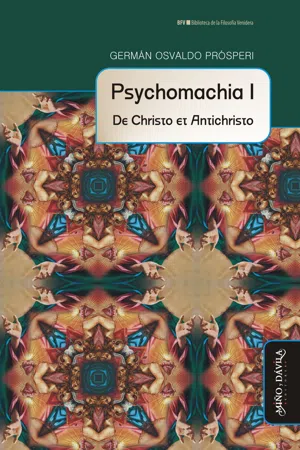
- 232 pages
- English
- ePUB (mobile friendly)
- Available on iOS & Android
eBook - ePub
About this book
Este libro analiza, desde una perspectiva psicogenética, la escisión esquizofrénica que define a la psiquis específica del cristianismo (siglos I-VIII) a partir de la tensión entre las figuras de Cristo, que funciona como vector simbólico-conjuntivo (eikon), y del Anticristo, que funciona como vector diabólico-disyuntivo (phantasma o eidolon).
Frequently asked questions
Yes, you can cancel anytime from the Subscription tab in your account settings on the Perlego website. Your subscription will stay active until the end of your current billing period. Learn how to cancel your subscription.
At the moment all of our mobile-responsive ePub books are available to download via the app. Most of our PDFs are also available to download and we're working on making the final remaining ones downloadable now. Learn more here.
Perlego offers two plans: Essential and Complete
- Essential is ideal for learners and professionals who enjoy exploring a wide range of subjects. Access the Essential Library with 800,000+ trusted titles and best-sellers across business, personal growth, and the humanities. Includes unlimited reading time and Standard Read Aloud voice.
- Complete: Perfect for advanced learners and researchers needing full, unrestricted access. Unlock 1.4M+ books across hundreds of subjects, including academic and specialized titles. The Complete Plan also includes advanced features like Premium Read Aloud and Research Assistant.
We are an online textbook subscription service, where you can get access to an entire online library for less than the price of a single book per month. With over 1 million books across 1000+ topics, we’ve got you covered! Learn more here.
Look out for the read-aloud symbol on your next book to see if you can listen to it. The read-aloud tool reads text aloud for you, highlighting the text as it is being read. You can pause it, speed it up and slow it down. Learn more here.
Yes! You can use the Perlego app on both iOS or Android devices to read anytime, anywhere — even offline. Perfect for commutes or when you’re on the go.
Please note we cannot support devices running on iOS 13 and Android 7 or earlier. Learn more about using the app.
Please note we cannot support devices running on iOS 13 and Android 7 or earlier. Learn more about using the app.
Yes, you can access Psychomachia I by Germán Osvaldo Prósperi in PDF and/or ePUB format, as well as other popular books in Philosophy & Ancient & Classical Philosophy. We have over one million books available in our catalogue for you to explore.
Information

Referencias bibliográficas
Adam, A. K. M. “Docetism, Käsemann, and Christology: Why Historical Criticism Can’t Protect Christological Orthodoxy”. Scottish Journal of Theology, vol. 49 (4), 1996, pp. 391-410.
AGAMBEN, G. (1979). Stanze. La parola e il fantasma nella cultura occidentale. Torino: Einaudi.
AGAMBEN, G. (1982). Il linguaggio e la morte. Un seminario sul luogo della negatività. Torino: Einaudi.
AGAMBEN, G. (1990). La comunità che viene. Torino: Einaudi.
AGAMBEN, G. (2000). Il tempo che resta. Un commento alla Lettera ai Romani. Torino: Bollati Boringhieri.
Agamben, G. (2002). L’aperto. L’ uomo e l’animale. Torino: Bollati Boringhieri.
AGAMBEN, G. (2005). Profanazioni. Roma: Nottetempo.
AGAMBEN, G. (2007). Il Regno e la Gloria. Per una genealogia teologica dell’economia e del governo. Homo sacer, II, 2. Vicenza: Neri Pozza.
AGAMBEN, G. (2014). L’uso dei corpi. Homo sacer, IV, 2. Vicenza: Neri Pozza.
AGUSTÍN DE HIPONA. Confessionum libri XIII, en Migne, J. P., (1845). PL, Vol. 32.
Agustín de Hipona. De civitate Dei, en Migne, J. P., (1864). PL, Vol. 41.
ALAIN DE LILLE (1955). Anticlaudianus, Texte critique avec une Introduction et des Tables, ed. de R. Bossuat. Paris: Vrin.
ALAIN DE LILLE (1973). Anticlaudianus or the Good and Perfect Man, ed. de J. Sheridan. Toronto: Pontifical Institute of Mediaeval Studies.
Alexandre, J. (2001). Une chair pour la gloire: L’Anthropologie réaliste et mystique de Tertullien. Paris: Beauchesne Éditeur.
ALLEAU, R. (1958). De la nature du symbole. Paris: Flammarion.
ANASTOS, M. “Nestorius Was Orthodox”. Dumbarton Oaks Papers, Vol. 16 (1962), pp. 117-140.
Anastos, M. V. (1979). Studies in Byzantine Intellectual History. London: Variorum Reprints.
Andreae, J. V. (1614). Collectaneorum mathematicorum decades XI. centum & decem tabulis aeneis exhibitæ. Tubingæ: typis J.A. Cellii.
Andreae, J. V. (1619). Reipublicae Christianopolitanae Descriptio. Strasburg: Lazarus Zetzner.
ATHERTON, M. “The image of the temple in ‘Psychomachia’ and late Angle-Saxon literature”. Bulletin of the John Rylands Library, 79(3), 1997, pp. 263-285.
ATTELL, K. (2015). Giorgio Agamben. Beyond the Threshold of Deconstruction. New York: Fordham University Press.
Ayres, L. (2004). Nicaea and Its Legacy. An Approach to Fourth-Century Trinitarian Theology. Oxford: Oxford University Press.
BAERT, B. (2004). A Heritage of the Holy Wood. The Legend of the True Cross in Text and Image. Leiden – Boston: Brill.
BAGCHI, D. “Christ’s Descent into Hell in Reformation Controversy”. Studies in Church History, Volume 45, 2009, pp. 228-247.
BALTHASAR, H. U. (1995). “Descent into Hell”, en Explorations in Theology, Vol. IV: Spirit and Institution, trad. Edward T. Oakes, S.J., San Francisco: Ignatius Press.
Barasch, M. (1995). Icon. Studies in the History of an Idea. New York – London: New York University Press.
BARDZELL, J. (2009). Speculative Grammar and Stoic Language Theory in Medieval Allegorical Narrative From Prudentius to Alan of Lille. New York – London: Routledge.
Bargeman, L. A. (2005). The Egyptian Origin of Christianity. Nevada City: Blue Dolphin Publishing.
BARR, J. (1992). The Garden of Eden and the Hope of Immortality. The Read-Tuckwell Lectures for 1990. London: SCM Press Ltd.
BARTHES, R. (1977). Fragments d’un discours amoureaux. Paris: Éditions du Seuil.
BAUCKHAM, R. “Synoptic Parousia Parables and the Apocalypse”. New Testament Studies, Volume 23, issue 02, 1977, pp. 162 – 176.
BECKER, A. H. “The “Evil Inclination” of the Jews: The Syriac Yatsra in Narsai’s Metrical Homilies for Lent”. Jewish Quarterly Review, Volume 106, Number 2, Spring 2016, pp. 179-207.
BEHR, J. (2000). Asceticism and Anthropology in Irenaeus and Clement. New York: Oxford University Press.
Belting, H. (2009). Imagen y culto. Una historia de la imagen anterior a la edad del arte, trad. C. D. Pampliega y J. E. Nuño. Madrid: Akal.
BENJAMIN, W. (1977). “Theologisch-politisches Fragment”, en Gesammelte Schriften, Band II/1. Frankfurt am Main: Suhrkamp, pp. 203-204.
Benjamin, W. (1980). Über den Begriff der Geschichte, en Gesammelte Schriften, Band I/2. Frankfurt am Main: Suhrkamp, pp. 693-704.
Benveniste, É. (1966). Problèmes de linguistique générale. Paris: Gallimard, Tome I.
BERARDINI, S. F. (2013). Ethos Presenza Storia. La ricerca filosofica di Ernesto de Martino. Trento: Università di Trento.
BERESÑAK, F. (2017). El imperio científico. Investigaciones político-espaciales. Buenos Aires: Miño y Dávila Editores.
BERNSTEIN, A. (2003). The Formation of Hell. Death and Retribution in the Ancient and Early Christian Worlds. London: UCL Press.
BLAKE, W. (1988). The Complete Poetry & Prose of William Blake. David V. Erdman (ed.). New York: Anchor Books.
BLANCHOT, M. (1955). L’espace littéraire. Paris: Gallimard.
BLANCHOT, M. (1969). L’entretien infini. Paris: Gallimard.
BLOCK, D. “Beyond the Grave: Ezekiel’s Vision of Death and Afterlife”. Bulletin for Biblical Research, 2 (1992), pp. 113-141.
BLUMENBERG, H. (1984). La leggibilità del mondo. Il libro come metafora della natura. Bologna: Società editrice il Mulino.
Bockmuehl, Markus y Carleton Paget, James (eds.) (2007). Redemption and Resistance. The Messianic Hopes of Jews and Christians in Antiquity. New York: T&T Clark.
Bollinger, L. “Placental Economy: Octavia Butler, Luce Irigaray, and Speculative Subjectivity”. Literature Interpretation Theory, 18, 2007, pp. 325-352.
BORGES, J. L. (1974). Obras completas. 1923-1972. Buenos Aires: Emecé.
Bronfen, E. “From omphalos to phallus: Cultural representations of femininity and death”. Women: A Cultural Review, 3:2, 1992, pp. 145-158.
BROOKE, J. H. (2014). Science and Religion. Some Histo...
Table of contents
- Introito
- Prólogo
- Introducción
- Aclaración preliminar
- CAPÍTULO I. Quarta persona Trinitatis
- CAPÍTULO II. Verbum phantasma factum est
- CAPÍTULO III. Descensus Christi ad inferos
- CAPÍTULO IV. Geminus Christi
- CAPÍTULO V. Textor Dei, textor hominum
- CAPÍTULO VI. De Christo et Antichristo
- Epílogo
- Post-scriptum. Tesis sobre (anti)mesianismo
- Coda
- Referencias bibliográficas